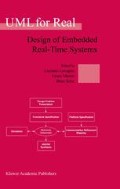Abstract
Message sequence charts (MSCs) constitute an attractive visual formalism that is widely used to capture system requirements during the early design stages in domains such as telecommunication software. A version of MSCs called sequence diagrams is one of the behavioral diagram types adopted in the UML. In this chapter we survey MSCs and their extensions. In particular, we discuss high level MSCs, which allow MSCs to be combined in various regular ways, and the more recent mechanism of communicating transaction processes, which can be used to structure sequence charts to capture system behaviors more directly. We also discuss in some detail live sequence charts (LSCs), a multi-modal extension of MSCs with considerably richer expressive power, and the play-in/out method that makes it possible to use LSCs directly as an executable specification.
Access this chapter
Tax calculation will be finalised at checkout
Purchases are for personal use only
Preview
Unable to display preview. Download preview PDF.
References
R. Alur, K. Etessami, and M. Yannakakis, “Realizability and verification of MSC graphs”, International Colloquium on Automata, Languages and Programming (ICALP), 2001.
R. Alur, G. J. Holzmann, and D. Peled, “An analyzer for message sequence charts”, Software Concepts and Tools, 17(2), 1996.
R. Alur and M. Yannakakis, “Model checking of message sequence charts”, Proceedings of the 10th International Conference on Concurrency Theory CONCUR’99, Lecture Notes in Computer Science 1664. Springer-Verlag, 1999.
H. Ben-Abdallah and S. Leue, “Timing constraints in message sequence chart specifications”, Proceedings of the Tenth International Conference on Formal Description Techniques, FORTE/PSTV’97. Chapman & Hall, 1997.
B. Caillaud, P. Darondeau, L. Helouet, and G. Lesventes, “HMSCs as partial specifications ⋯ with PNs as completions”, Modeling and Verification of Parallel Processes 4th Summer School, MOVEP 2000, LNCS 2067, 2001.
W. Damm and D. Harel, “LSCs: Breathing life into message sequence charts”, Formal Methods in System Design, 19(1), 2001.
N. Halbwachs, Synchronous Programming of Reactive Systems. Kluwer Academic Publications, 1993.
D. Harel, “Statecharts: A visual formalism for complex systems”, Science of Computer Programming, 8, 1987.
D. Harel, “From play-in scenarios to code: An achievable dream”, IEEE Computer, 2001.
D. Harel and E. Gery, “Executable object modeling with statecharts”, IEEE Computer, 30(7), 1997.
D. Harel and H. Kugler, “Synthesizing state-based object systems from LSC specifications”, International Journal on Foundations of Computer Science, 13(1), 2002.
D. Harel, H. Kugler, R. Marelly, and A. Pnueli, “Smart play-out of behavioral requirements”, International Conference on Formal Methods in Computer Aided Design (FMCAD), 2002.
D. Harel and R. Marelly, “Playing with time: On the specification and execution of time-enriched LSCs”, Proceedings of the 10th IEEE/ACM Int. Symp. on Modeling, Analysis and Simulation of Computer and Telecommunication Systems MASCOTS 2002. ACM Press, 2002.
D. Harel and R. Marelly, Come, Let’s Play: Scenario-Based Programming Using LSCs and the Play-Engine. Springer-Verlag, 2003.
J.G. Hendriksen, M. Mukund, K.N. Kumar, and P.S. Thiagarajan, “Message sequence graphs and finitely generated regular MSC languages”, International Colloquium on Automata, Languages and Programming (ICALP), LNCS 1853, 2000.
J.G. Hendriksen, M. Mukund, K.N. Kumar, and P.S. Thiagarajan, “Regular collections of message sequence charts”, Mathematical Foundations of Computer Science (MFCS), LNCS 1893, 2000.
I-Logix Inc. Products Web Page. http://www.ilogix.com/fs_prod.htm.
P. B. Ladkin and S. Leue, “Interpreting message flow graphs”, Formal Aspects of Computing, 7(5), 1995.
M. Lettrari and J. Klose, “Scenario-based monitoring and testing of real-time UML models”, International Conference on the Unified Modeling Language, Toronto, 2001.
P. Lucas, “Timed semantics of message sequence charts based on timed automata”, In Oded Maler Eugene Asarin and Sergio Yovine, editors, Electronic Notes in Theoretical Computer Science, volume 65. Elsevier Science Publishers, 2002.
J. Magee, N. Pryce, D. Giannakopoulou, and J. Kramer, “Graphical animation of behavior models”, International Conference on Soft. Eng. ICSE’00, Limeric, Ireland, 2000.
R. Marelly, D. Harel, and H. Kugler, “Multiple instances and symbolic variables in executable sequence charts”, Proceedings of the 17th ACM conference on Object-oriented programming, systems, languages, and applications. ACM Press, 2002.
A. Muscholl and D. Peled, “Message sequence graphs and decision problems on mazurkiewicz traces”, Proceedings of the 24th International Symposium on Mathematical Foundations of Computer Science MFCS’99, Lecture Notes in Computer Science 1672 Springer-Verlag, 1999.
A. Muscholl, D. Peled, Z. Su, “Deciding properties for message sequence charts”, Proceedings of the 1st International Conference on Foundations of Software Science and Computation Structures FOSSACS’98, Lecture Notes in Computer Science 1378. Springer-Verlag, 1998.
M. Nielsen, G. Plotkin, and G. Winskel, “Petri nets, event structures and domains”, Theoretical Computer Science (TCS), 13, 1981.
M. Nielsen and P.S. Thiagarajan, “Regular event structures and finite petri nets: The conflict-free case”, Proceedings of the 23rd International Conference on the Applications and Theory of Petri Nets ICATPN 2002, Springer Lecture Notes in Computer Science 2360. Springer-Verlag, 2002.
A. Roychoudhury and P.S. Thiagarajan, “Communicating transaction processes”, Proceedings of Third International Conference on Applications of Concurrency to System Design ACSD’03 (to appear). IEEE Press, 2003.
B. Selic, G. Gullekson, and P. Ward. Real-Time Object-Oriented Modeling. John Wiley and Sons, 1994.
W. Thomas, “Languages, automata, and logic”, In A. Salomaa G. Rozenberg, editor, Handbook of Formal Language Theory, Volume III. Springer-Verlag, 1997.
S. Uchitel, J. Kramer, and J. Magee, “Detecting implied scenarios in message sequence chart specifications”, European Software Engineering Confernece and 9th ACM SIGSOFT International Symposium on the Foundations of Software Engineering ESEC/FSE’01. Vienna, Austria, 2001.
Author information
Authors and Affiliations
Editor information
Editors and Affiliations
Rights and permissions
Copyright information
© 2003 Kluwer Academic Publishers
About this chapter
Cite this chapter
Harel, D., Thiagarajan, P.S. (2003). Message Sequence Charts. In: Lavagno, L., Martin, G., Selic, B. (eds) UML for Real. Springer, Boston, MA. https://doi.org/10.1007/0-306-48738-1_4
Download citation
DOI: https://doi.org/10.1007/0-306-48738-1_4
Publisher Name: Springer, Boston, MA
Print ISBN: 978-1-4020-7501-8
Online ISBN: 978-0-306-48738-5
eBook Packages: Springer Book Archive

